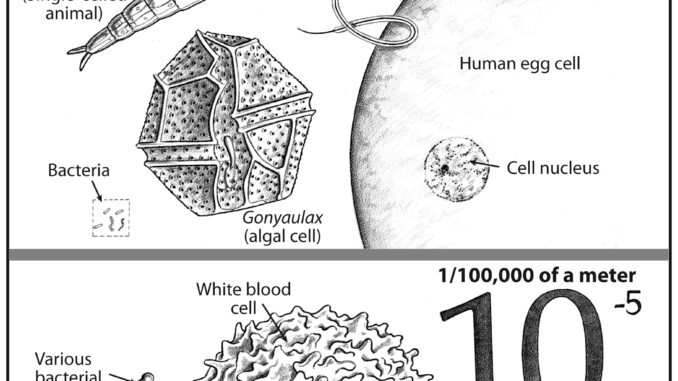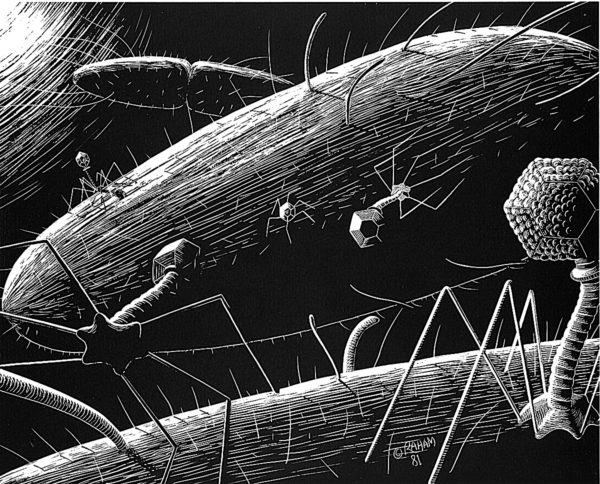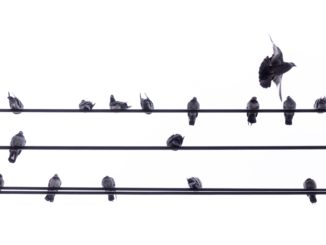
By R. Gary Raham
A biologist-artist’s ruminations about our roles in a science-inspired world
Viruses make us sick and sometimes kill us. They are unseen enemies so small they ride the vapors we respire or transfer with the touch of a finger. The SARS (Sudden Acute Respiratory Syndrome) and MERS (Middle East Respiratory Syndrome) epidemics caused by corona viruses provides a good examples. When attacked we look for a defense. Antibiotics come to mind, but antibiotics only work against bacteria, not viruses. We tend to lump these two microscopic classes into one ball of misery, but they differ greatly—both in size and modus operandi. And sometimes—most times, actually—microbes either pay us no mind or even provide necessary services. In fact, our bodies are best described as microbe condominiums accented with a framework of human cells.
Bacteria are complete, but tiny living things. They reproduce, respire, and move independently—like any respectable organism. But a bacterium could orbit a human cell the way a satellite orbits the Earth. A bacterium is a no-frills dingy of life compared to a human packed with ocean-liner-sized complex cells all working together.
Viruses are a thousand times smaller than a bacterium—and they can’t reproduce without help. Viruses contain the blueprints for more viruses, but they have to commandeer the machinery of more complex cells to actually build them. Hence, doctors have to fight disease-causing bacteria and viruses differently.

Because bacteria are complete cells (though small), they contain everything they need to live independently and reproduce. Cell walls provide a barrier to the outside environment. They possess genetic code (in the form of RNA or DNA) that allows them to reproduce and manage necessary metabolic reactions. They have the tiny factories called ribosomes where necessary materials get fabricated under the direction of DNA or RNA. Antibiotics can attack them on several fronts. Penicillins, for example, attack cell wall manufacture. Other antibiotics attack bacterial cell membranes, interfere with the bacterium’s ability to make RNA and DNA, or impair protein manufacture in ribosomes.
Science knows less about how viral vaccines work. They have often found good ones by trial and error. In general, viral vaccines beef up the responses of our natural immune system defenses in various ways. We have T-cells and B-cells with the ability to recognize the protein coatings on viruses or the RNA or DNA housed within those protein shells.
If antibiotics are used too much—either because they are prescribed for viral infections, on which they have no effect, or because they are used indiscriminately to improve meat production, bacteria quickly evolve defenses. As a result, doctors loose valuable weapons against disease. But bacteria are also victims of viral attack. One ironic solution to a loss of effective antibiotics may be to find specific viruses that can be used against harmful bacteria.
In any case, modern science still has much to learn about the tiny creatures that can be either friend or foe. We have to learn to slay the enemy microbes without killing the ones that become intimate (and necessary) partners. In the meantime, do what Mom always said to do: wash your hands often, be mindful of what you touch, and cover your mouth when you cough or sneeze.
Gesundheit!
Support Northern Colorado Journalism
Show your support for North Forty News by helping us produce more content. It's a kind and simple gesture that will help us continue to bring more content to you.
BONUS - Donors get a link in their receipt to sign up for our once-per-week instant text messaging alert. Get your e-copy of North Forty News the moment it is released!
Click to Donate



